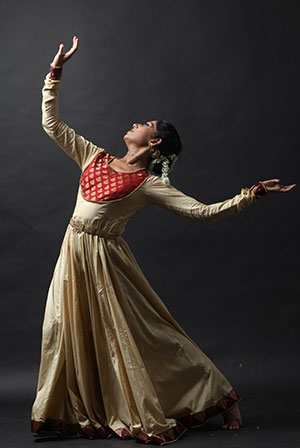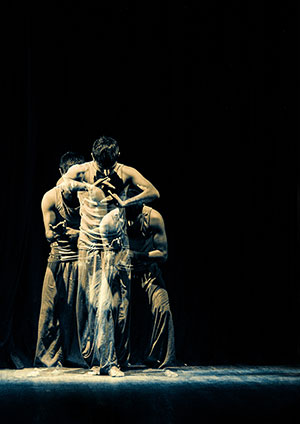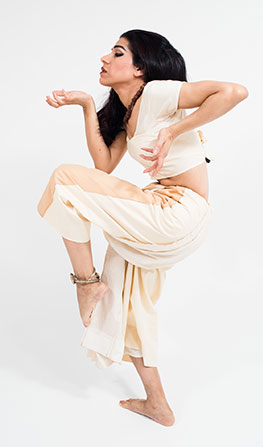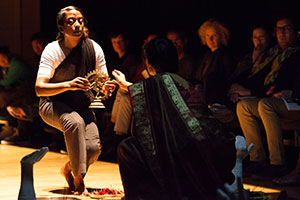|
| |
Aravan - The Desolate |
 |
Dancer: Dr. Mitul Sengupta
Music: Vocals - Debasis Sarkar, Tabla - Biswajit Pal, Sitar- Chandrachur Bhattacharya, Sarangi- Umesh Mishra, Paranth- Shibayan Ganguly
Music Composer: Dishari
Arrangements: Bernerd D'Souza and Munnu Shaw
Choreography: Shambik Ghose and Dr. Mitul Sengupta
Presenting an episode from the Kurukshetra War in the Mahabharata, where Aravan, the son born of Ulupi and Arjuna, was convinced to sacrifice his life to save the Pandavas from losing the war, as a sacrifice to Lord Kali. It is the dance of the desolate and song of the voices, which echoes from the deep within “that we are trapped, unheard of and desolate.” |
|
Morphed |
 |
Dancer: Subhash Viman Gorania
In Morphed, Indian artist Veena Basavarajaiah creates a choreographic work on ‘British
Asian’ dancer Subhash Viman exploring the Identity, home and belonging. The resulting
piece of work dissolves constructed images of the ‘other’ and the acknowledgement of a
cacophonic identity of the self. The piece looks at how regardless of their national identities
they embrace, abandon, adapt, adopt ideologies of nationalism, home, religion and culture
to weave images of the ‘self’ to present and represent their existence. Morphed, is a
choreographic work that portrays how every individual is indefinitely morphing identities to be recognized and accommodated in today’s global world. |
|
Not Your Mothers |
 |
Choreographed and Danced by - Leah Raphael Curtis and Emily Mcloughlin of Delhi Dance Theater
Music by - Eric Fraser (Bansuri), Abhik Mukherjee (Sitar) and Ehren Hanson (Tabla)
Not Your Mothers, uses the medium of Contemporary dance, Kathak and live original music to explore the changing roles of women in modern India in reaction to recent social change. It observes the current generations conflict between staying true to tradition or stepping forward into modernity and the affect this has on relationships and identity.
Delhi Dance Theater (DDT) is a collaborative company that unites artists from different disciplines to create work in dance, music and film for international performance. DDT draws inspiration from Indian and Western classical dance, creating process oriented art in both music and dance as well as explorations in film to generate an aesthetic that is clean, colorful and evolving. DDT performs annually in New York City and India.
|
|
The Vermin’s Will |
 |
| Photo credit: Kateryna Odyntsova |
|
Dancer: Mesma Belsare
Directed by Dr. Maya Kulkarni
Content Expert: Dr. Robert Perinbanayagam
Music by Sadgurunatha Odhuvar, T A Kaliyamurthy, G Balasubramaniam
Concept, Choreography and Costume by Mesma Belsaré
The Vermin’s Will is inspired by SAIVA Siddhantam in Mannikavasagar’s Siva Puranam and Psychologist Carl Jung’s studies of the human archetype.
An undefined being plagued by his inadequacies hovers in the space between memories of his past lives as a tree, a bird and a snake. Through Shivan’s Grace he realizes that suffering lurks in the incessant cycle of being born and then turning to ashes upon death.
In the process he identifies with three aspects of Shivan: the one who drank the poison that surfaced when oceans were churned, the one inseparable from Devi, his feminine aspect and the one from whose matted hair flows the river Ganga.
|
|
We Used to See This |
 |
| Photo credit: Stephen Gorme |
|
Dancer: Meena Murugesan
Music credits: D. Sabela Grimes
Choreographer: Meena Murugesan in collaboration with Shyamala Moorty
We Used to See This is a performance work that re-choreographs some of the disparate spaces that bharata natyam has been performed in over the centuries: the salon, the temple, and the proscenium stage. We Used to See Thisinvites audiences to experience chosen fragments of bharata natyam's past and present, revisiting classical Indian dance movement, rituals, sounds, spaces, and archival film within a post-modern choreographic structure. Join Meena as she journeys through a dance that is simultaneously seen as traditional, classical, modern, colonized, orientalized, and re-constructed, depending on one’s perspective. We Used to See This asks: What happens when different spatial relationships are cultivated between performer and audience? How is intimacy created in the proscenium versus in the salon space? How can oppressive stereotypes be deconstructed and transformed through performance? We Used to See This re-writes, re-interprets, and re-imagines. |
|
| |
|
|






